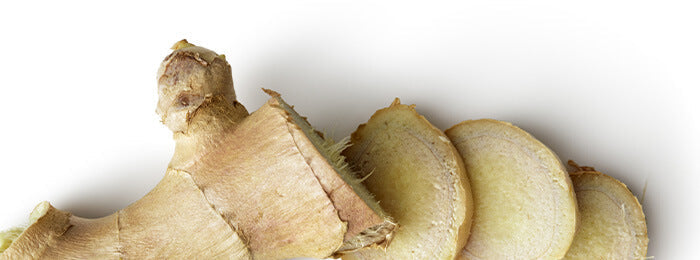Ginger and artichoke have been a staple of traditional medicine for centuries.1,2 Ginger (Zingiber Officinale), part of the Zingiberacear family is native to South East Asia, China and India. Based on the appearance of the root, in Sanskrit ginger is referred to as Srngaveram, meaning, "horn root." Ginger is a flowering plant, which grows to about one meter in height and is typically harvested in 8-10 months. The thick outer skin of the root must be removed before preparation or consumption. The applicable part of ginger is the rhizome and root, the active constituents being gingerols and shogaols.
Artichoke (Cynara cardunculus) root, leaf, and stem have multiple properties making it a well-used herb in traditional medicine as well as current medicine. It is a perennial plant native to regions within the Mediterranean and is part of the Asteraceae family. Artichoke grows up to 1.5-2 meters tall, with a large bud and flowers developing out of the bud. The bud and heart are edible, while the choke (within the center of the bud) is inedible.
Mechanisms of Ginger and Artichoke
The primary active molecules found in artichoke are cyanidin, cynaropicrin, tannins, caffeoylquinic acids, and flavonoids, luteolin. Most likely due to its cynarian content, artichoke leaf extract has been shown to have a choleretic effect, supporting bile production and bile flow.*4
In a randomized placebo-controlled double-blind cross-over study, through the intra-duodenal route, 20 participants were administered a single dose of artichoke extract. Results were measured through intra-duodenal bile section using probes; 30 minutes after administration there was an increase of bile by 127.3%, 60 minutes, 151% increase in bile secretion and after 60 minutes there was an increase of 94% in bile secretion when compared to baseline.*4
Clinical studies have confirmed the use of artichoke has been shown to be beneficial in digestion*; a double-blind, randomized controlled, multicenter trial, 247 patients received either a placebo or 320 mg twice daily of artichoke leaf extract over a period of six weeks. Results showed a higher quality of life when compared to placebo as well as a significant reduction in occasional gastrointestinal symptoms.*5
A second study looked at the use of artichoke leaf extract and adults with occasional digestive upsets. Of the 208 adults completing the study, there was a 26.4% fall in symptoms and a 20% improvement in the quality of life scores after the 2-month intervention of artichoke leaf extract.*6
Migrating motor complexes (MMC) is present within the gastrointestinal tract, specifically in the stomach and the small bowel. Migrating motor complex is a four-part complex with a multitude of varying contractions within each phase; phase three being the most active. The complex is controlled by the enteric hormone, motilin, and 5-hydroxytryptamine (5-HT). Motility receptors are located within the muscle cells of the GI tract, myenteric plexus, and the mucosa.7 Serotonin is present in the enterochromaffin cells of the mucosa and the myenteric neurons. Altered serotonin signaling can potentially lead to gastrointestinal symptoms.8 An impaired or delayed migrating motor complex has been shown to support digestion and increase postprandial dyspeptic symptoms.*9
Studies and traditional medicine have both shown the benefits of ginger are likely due to the active ingredient gingerols. Ginger has been shown to increase antral motility during phase III of the migrating motor complex during both times of fasting and postprandially.*10 Another active constituent in ginger, galanolactone is thought to work as an antagonist of illeal 5-HT receptors.*11
Ginger and artichoke have recently been studied in combination. Ginger and artichoke extracts were used in a 2015 126-person multicenter, double-blind, randomized, placebo-controlled trial.12 A placebo or one capsule of the combination of extracts (Cynara cardunculus and Zingiber officinale) was given prior to lunch and prior to dinner for a period of four weeks. Gastric function was measured by observing nausea, fullness, and satiety, bloating and stomach discomfort. The group receiving the extracts experienced significant changes in only 14 days when compared to the placebo group and maintained a significant reduction in symptoms throughout the 28-day study.*
REFERENCES:
1. Langner E et al. Adv Ther. 1998 Jan-Feb;15(1):25-44.
2. Salem M et al. Plant Foods Hum Nutr. 2015 Dec;70(4):441-53.
3. Elsebai MF et al. Front Pharmacol. 2016 Dec 8;7:472. doi: 10.3389/fphar.2016.00472.
4. Kirchhoff R et al Phytomedicine. 1994 Sep;1(2):107-15.
5. Holtmann G et al Aliment Pharmacol Ther. 2003 Dec;18(11-12):1099-105.
6. Bundy R et al. J Altern Complement Med. 2004 Aug;10(4):667-9.
7. Takeshita E et al. J Gastroenterol. 2006 Mar; 41(3):223-30.
8. Sikander A, et al. Clin Chim Acta. 2009 May;403(1-2):47-55.
9. Takahashi T. J Smooth Muscle Res. 2013; 49: 99-111.
10. Micklefield GH et al. Int J Clin Pharmacol Ther. 1999 Jul;37(7):341-6.
11. Pertz HH et al. Planta Med. 2011 Jul;77(10):973-8.
12. Giacosa A et al. Alternat Med. 2015;2015:915087.



